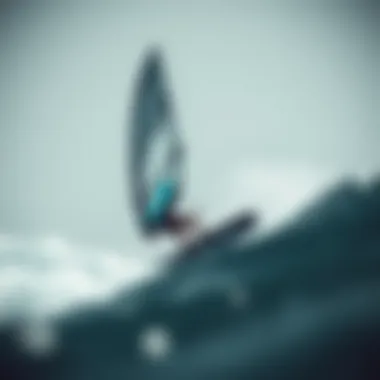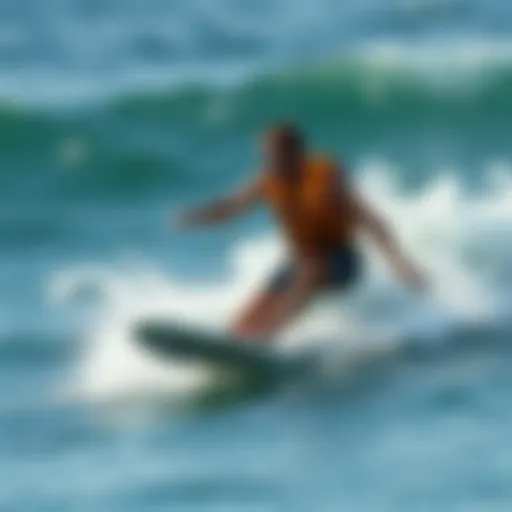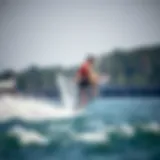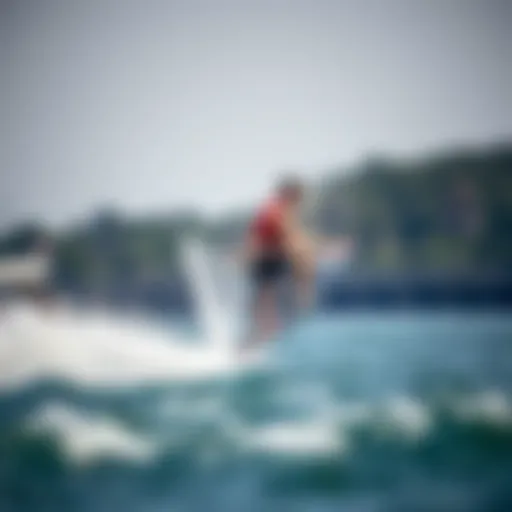The North Foil: A Deep Dive into Kiteboarding Gear


Intro
The North Foil is more than just a kiteboarding tool; it represents a significant advancement in water sports equipment that allows enthusiasts to carve through the waves like a hot knife through butter. For kiteboarders—be they new to the sport or seasoned pros—the foil is key. Understanding its nuances means not just a better ride but a safer experience out on the water.
Before diving headfirst into techniques for maximizing your time with the North Foil, it's crucial to grasp the core components of this equipment. Not only does the North Foil offer immense versatility in various wind conditions, but its design also contributes to performance efficiency and control. With that said, let’s break down the techniques that kiteboarding enthusiasts can employ to truly harness the power of this foil.
Techniques for Kiteboarding Enthusiasts
Beginner Techniques
For those just starting out, the key is to develop a solid foundation. Here are some essential techniques:
- Body Positioning: Keep your weight centered, knees slightly bent, and arms extended. This stance helps balance the foil as you begin to gain speed.
- Using the Kite: Learn to control the kite effectively. Start by positioning it in the power zone and pulling on the bar to initiate movement.
- Glide Control: Initially, keep the foil submerged and focus on maintaining a steady glide before attempting to lift.
- Practice Turns: Once comfortable, practice gentle turns. Shift your weight with your front foot to guide the direction of the board seamlessly.
For a fantastic visual guide, check out mainstream kiteboarding forums where fellow kiteboarders share their videos and tips under various conditions.
Advanced Maneuvers
Once you’re comfortable with the basics, elevating your skills is the next step. Here are some advanced maneuvers you can work towards:
- Foiling Jumps: With enough speed, you can push off the water and perform jumps. Timing and body control are critical here.
- Transitions: These involve changing direction while foiling. Shift your weight to the back foot during turns—this keeps you flying gracefully, almost like a bird gliding.
- Carving: This technique requires agility and precision. Lean back, use your front foot for pressure, and carve through the water for smooth turns.
Each of these skills takes practice. The beauty of kiteboarding is in its learning journey, where every session brings a potential breakthrough.
Equipment Reviews
As gear is a crucial part of kiteboarding, the North Foil deserves special attention when it comes to reviewing specific kite and board pairings.
Kite Reviews
One stellar example of kites that complement the North Foil well is the North Reach. This kite offers an impressive wind range, so it allows you to use your foil effectively across different conditions. Users praise its responsive handling and great lift, making it a reliable choice for foilers at any level.
Board Reviews
When it comes to boards, the North Pulse stands out. It’s lightweight and provides excellent stability, making it easier for beginners to find their footing. For experienced riders, its agility and performance under gusty winds are top-notch, allowing for advanced tricks and maneuvers.
Each session on the water improves your skills while reinforcing your understanding of how to maintain the gear effectively.
"Practicing today means shredding tomorrow."
As you venture deeper into the world of kiteboarding, keep refining your techniques and undertaking regular equipment checks. Continual learning and adaptation are what make the experience fulfilling. For more discussions and information, check out Kiteforum where you can access countless threads discussing gear optimization and personal experiences.
Foreword to North Foils
Kiteboarding has rapidly evolved from its origins into a dynamic sport, captivating enthusiasts around the globe. Central to this growth is the technology behind the gear used, particularly the North Foil. This section outlines why understanding this particular piece of equipment matters—not only for performance but also for enhancing the overall kiteboarding experience. By diving into the intricacies of the North Foil, riders can appreciate how it influences their sailing experience, affording them greater control, speed, and efficiency on the water.
Definition and Significance
The North Foil is an innovative type of hydrofoil specifically designed for kiteboarding. Its design significantly reduces drag while maximizing lift, allowing riders to glide effortlessly above the water's surface. This not only leads to a smoother ride but can also enhance speed and maneuverability. Riders using North Foils can explore a variety of conditions, making it a popular choice among those looking to expand their kiteboarding horizons.
Overview of Kiteboarding Equipment
Kiteboarding equipment comprises various components, each contributing to the overall performance and experience on the water. Understanding these components is crucial for making informed decisions and tailoring gear to personal preferences.
Kite Types
Different kite types are essential in kiteboarding. They can vary notably in shape, size, and design. For instance, a C-shaped kite is favored by many for its powerful lift and responsiveness, favored in freestyle maneuvers. On the other hand, delta kites, with their broader wingspan, are known for stability and ease of use, making them a popular choice for beginners. Choosing the right kite depends on the rider’s skill level and the conditions expected on the water.
The versatility of these kites means that riders can select one that best suits their style whether they’re aiming for jumps, tricks, or cruising.
Boards and Bindings
When it comes to boards and bindings, the right set can make or break a kiteboarding session. Options range from twin-tip boards, which are great for all-around use, to directional boards designed for specific riding styles such as wave riding.
Bindings are equally important—they provide the connection between the rider and the board, affecting control and comfort. Comfortable, well-fitting bindings will enhance a rider’s ability to maneuver through waves or chop, thereby improving the overall experience. However, not all bindings are created equal, and the choice often comes down to personal preference and riding style, necessitating a thoughtful selection process.
Foils
Foils act as the backbone of hydrofoil kiteboarding. They are crafted in several styles to cater to different riding conditions and preferences. For example, a high-aspect foil is designed for speed and efficiency, while a low-aspect foil may provide more stability during tricky conditions. The design of a foil can significantly impact lift-off speed and stability, essential for those looking to push their limits on the water.
Understanding the distinctions among foils ensures riders select the equipment that matches their skill level and the specific environments they wish to explore, laying a robust foundation for mastering the sport.
In summary, comprehension of kite types, boards, bindings, and foils is integral to maximizing the kiteboarding experience, particularly when integrating the performance of North Foils into each session. These elements harmonize to provide not just a ride, but an adventure on the water, offering limitless possibilities for those eager to embrace the thrill.
Evolution of Foil Technology
The evolution of foil technology marks a remarkable journey in kiteboarding, shaping how enthusiasts interact with water and wind. Understanding its development not only speaks to the sport's innovations but also highlights how these advancements have revolutionized riders' experiences. Advances in materials, designs, and performance metrics provide a deeper appreciation of what kiteboarders now enjoy. There’s a clear trajectory from rudimentary beginnings to the precision-engineered tools available today. This section explores historical developments, cutting-edge design innovations, and the latest trends in foil technology, offering insights that could steer beginners and seasoned riders alike toward informed selections.
Historical Context
The roots of foil technology can be traced back to the late 20th century, where simple watercraft relied heavily on traditional concepts of lift and drag. Early pioneers in kiteboarding began experimenting with handlebars and floats, attempting to harness the power of the wind alongside water resistance. As kite design matured, aficionados started to dream of foils that would allow for a smoother ride above the surface.


The breakthrough came when inventors recognized that lifting a board off the water reduced drag, subsequently increasing speed and performance. The early 2000s witnessed an initial wave of foils on the market, often clunky and less efficient by today’s standards. As the years rolled on, manufacturers began using lighter materials, such as aluminum and carbon fiber, allowing for a significant evolution in structure and performance. These frames, combined with refined wing shapes, enabled riders to cut through waters seamlessly.
Innovations in Design
Fast forwarding to the present, innovations in foil design have significantly altered how riders experience the sea. Key elements of design include:
- Wing Shape: The aerodynamic design enables longer rides with less effort. Modern wings often have specific curvature to optimize lift at various speeds.
- Aspect Ratio: A higher aspect ratio typically offers better performance, allowing for more efficient angles while carving through water and less drag. Newer foils often leverage this principle without sacrificing stability.
- Increased Stability Features: Manufacturers have integrated features such as adjustable foils that allow riders to modify settings based on conditions. This adaptability helps cater to varying skill levels and environmental factors, thereby enhancing control.
These innovations are not merely seats of convenience but are integral to riders’ experiences, directly impacting their choice of equipment and ability to master techniques.
Current Trends in Foil Development
In the fast-paced world of kiteboarding, trends in foil development evolve rapidly. Lately, a few standout themes have emerged in the evolution of foil technology:
- Environmentally Friendly Materials: As awareness grows regarding sustainability, many manufacturers are exploring eco-friendly materials that lessen their carbon footprint while maintaining performance.
- Smart Technology Integration: Some foils now come equipped with sensors that provide real-time feedback on speed and performance, allowing riders to refine their techniques dynamically.
- Customizable Designs: Manufacturers are moving towards offering customizable options that enable riders to choose wing shapes and materials tailored to their specific riding style and preferences.
"The evolution of foil technology isn't just about speed; it's about understanding the water beneath your board and creating synergy with the environment".
As the kiteboarding scene continues to evolve, observing these trends will help riders keep their gear relevant and enhance their performance effectively.
The Construction of the North Foil
The construction of the North Foil is a pillar of its performance and reliability in kiteboarding. Understanding how these foils are built is crucial for enthusiasts who wish to optimize their gear. From materials to design features, each component serves a purpose that can significantly enhance the riding experience.
Materials Used
Carbon Fiber
Carbon fiber is a material that stands out in kiteboarding foils for its remarkable strength-to-weight ratio. This unique characteristic allows for lightweight construction, making the foils much easier to maneuver without compromising stiffness. The lightweight nature of carbon fiber aids in achieving faster speeds with less effort, which is often what kiteboarders are looking for in performance situations.
However, this material can be somewhat delicate compared to others. While it provides top-tier performance, riders must handle it with care to avoid damages from hard impacts. All in all, the lightweight benefits of carbon fiber make it a favored choice in many high-performance North Foils.
Aluminum
Aluminum is another material used in the construction of some North Foils, particularly in the lower-cost models. It boasts durability and resistance to corrosion, making it suitable for saltwater conditions. This material is typically heavier than carbon fiber but offers a sense of sturdiness that appeals to beginners or those riding in more challenging water conditions.
One noteworthy aspect of aluminum foils is that they’re less prone to cracks or breaks if not babied. However, to some kiteboarders, the added weight can be a downside, especially when it comes to speed and agility.
Composite Materials
Composite materials combine multiple elements to leverage the strengths and minimize the weaknesses of each. In the context of North Foils, composites often merge fiberglass with other materials for enhanced performance. This means you can enjoy a balance between lightweight designs and significant durability.
A unique feature of composites is their adaptability, allowing manufacturers to fine-tune the properties of the foils according to specific needs. As a downside, composites typically lack the stiffness of carbon fiber, which means the performance might not reach the absolute highest levels.
Design Features
Wing Shape
Wing shape plays a significant role in how the foil interacts with the water. North Foils usually feature a carefully crafted wing shape that promotes efficient lift. The design of these wings aims to minimize drag and maximize performance, enabling riders to glide smoothly over the water. Riders appreciate a well-structured wing that can catch wind effectively for powerful lift.
However, achieving a perfect balance is key. While a certain wing shape may excel in one condition, it might not do as well in another. Riders should consider where and how they plan to use their foils when evaluating wing shapes.
Aspect Ratio
The aspect ratio of a foil relates to the ratio of the wing's length to its width. A higher aspect ratio generally promotes speed and efficiency. This feature is often sought after by advanced riders aiming for performance. In contrast, those who just want an easier time might prefer a lower aspect ratio that provides stability and easier handling.
The unique character of aspect ratio affects not only speed but also the riding experience. More advanced kiteboarders generally value a higher aspect ratio, while casual riders might benefit from a design that offers less tilt and more stability in the water.
Stability Features
Stability is crucial when kiteboarding, particularly for beginners. North Foils incorporate various stability features that help maintain a consistent ride. A well-constructed stability system helps riders avoid the pitfalls of erratic movements on the water, especially in gusty or choppy conditions.
Interestingly, these stability features can sometimes come at the expense of agility. A foil that is very stable may struggle to twist and turn with the same fluidity as one that is designed purely for performance. Thus, finding the right balance is essential for each rider's unique style.
"Understanding the fundamental construction is key to enhancing your performance on water."
Each material and design trait contributes to the overall experience a kiteboarder encounters on the water. Riders must align their personal preferences with these elements carefully for an enriched kiteboarding journey.
Performance Characteristics
Performance characteristics are the backbone of any kiteboarding experience. When it comes to the North Foil, understanding these traits can significantly impact how enthusiasts—from beginners to seasoned pros—interact with the water. High performance in essential areas like speed, lift, and durability not only enhances your ride but also ensures safety and enjoyment on the water. Let's take a closer look at these crucial components.
Speed and Agility
Speed in kiteboarding relates not only to thrill but also to control. With the North Foil, riders often find themselves slicing through the water with effortless ease. This can be attributed to the unique wing design that reduces drag and supports rapid movement.
A key element to achieving speed is the aspect ratio of the wing. A higher aspect ratio generally allows for a more extended wing span, creating a thinner profile that minimizes drag. This, coupled with the foil’s lightweight construction, affords riders a swift and nimble experience.
Agility, on the other hand, adds another facet to performance. North Foils are engineered with responsive designs that permit sharp turns and quick maneuvers. When approaching challenging conditions—perhaps a sudden gust of wind or choppy waters—having the capacity to react swiftly makes all the difference. For many, this responsiveness translates into confidence, supporting dynamic styles and quick directional changes that are essential for advanced tricks and navigating tight spaces.
Lift and Glide


Lift is a pivotal factor for kiteboarders, as it determines how effectively the rider can ascend above the water's surface. The North Foil excels in generating lift due to its specialized wing contours. These contours create a pressure differential—resulting in lift and allowing riders to effortlessly skim above the water.
Glide, on the other hand, is about maintaining speed without unnecessary effort. When an experienced rider harnesses the lift that the North Foil provides, they can experience a smooth glide. This means less constant energy exertion, allowing for longer rides with less fatigue. The interplay between lift and glide offers a freedom on the water that can deepen one’s skills and transform the riding experience.
Durability and Maintenance
Durability is a paramount consideration, especially with the rigors that kiteboarding equipment faces. The North Foil is constructed from high-quality materials—composite blends of carbon fiber and aluminum offer both robustness and lightness. This ensures that the foil can withstand impacts from challenging conditions without compromising its functionality. Riders can feel secure performing tricks or navigating rough waters, knowing their equipment can handle the wear and tear.
Maintenance of the North Foil is straightforward yet necessary. Regular inspection of the components, particularly the wings and fuselage connections, should not be neglected. After every few rides, a simple rinse with fresh water followed by proper drying can significantly extend the lifespan of the foil. Periodic checks can catch early signs of wear, ensuring you don't end up with a mishap on your next adventure.
"Proper care of your North Foil not only improves performance but can also save you from unexpected issues on the water."
In summary, understanding the performance characteristics of the North Foil equips riders with insights that greatly enhance their kiteboarding journey. From speed and agility to lift and glide, and the necessity of maintenance, these elements coalesce to create an enjoyable and efficient water sports experience. Whether setting out for your first session or chasing after the next big wave, these characteristics shape every adventure on the water.
Choosing the Right North Foil
Selecting a North Foil might seem simple at first glance, but dive a lil' deeper, and it reveals a complexity that's vital for optimizing your kiteboarding experience. The right foil is not just a piece of equipment; it can make or break your session. When kiteboarding enthusiasts come together, they often discuss the importance of tailoring gear to personal preferences and conditions.
Factors to Consider
Skill Level
Skill level plays a pivotal role in your choice of North Foil. Beginners often find themselves overwhelmed by the choices available. A foil meant for a novice typically provides added stability and easier maneuverability. This is vital to build confidence without biting off more than you can chew in the beginning. A key characteristic of beginner foils is their design, which often focuses on broad wings. They help lift off the water sooner, creating a smoother introduction to the sport, which keeps the experience enjoyable.
Advantages of targeting a beginner-friendly foil include a gentler learning curve and the ability to practice in a relaxed manner. However, this choice does come with a disadvantage. Some of these foils may not perform as well in high-wind conditions, limiting your progression as skills develop.
Water Conditions
Another essential consideration is the water conditions. The North Foil's performance will significantly differ based on whether you're riding in choppy waters, flat lakes, or ocean swells. Flat water usually favours foils that are designed for speed; these have a narrower wing profile and allow for faster-paced rides. On the other hand, in choppy or rough conditions, wider wings can provide better stability and control.
The unique feature of water conditions is that they determine the kind of riding experience you might seek. Choosing a foil suited to the common conditions you encounter will lead to a rewarding experience. However, navigating tricky waters might mean forgoing certain design advantages, resulting in a balancing act between performance and conditions.
Desired Performance
Lastly, understanding your desired performance is key. Are you looking to race against the clock, or are you interested in executing high-flying jumps? Different foils respond uniquely based on performance goals. For speed, a higher aspect ratio foil would be your best bet. This design allows for quick directional changes and a thrilling ride.
Conversely, if your aim is to become a master of jumps and tricks, you'd want a foil that can lift you easily and allow for a range of motions during airtime. The key characteristic of performance-focused foils is their shape, which directly impacts lift. However, it's worth noting that these performance-driven foils can often be less forgiving for those still working on their techniques.
Recommended Models
Beginner Options
For those just starting their kiteboarding journey, models like the North Nova serve as a stellar entry point. They are designed with user-friendliness and safety in mind. A key characteristic of this model is its amazing stability, which means even on your first time out, you won't find yourself worrying about losing control. Plus, it provides generous lift, making it easier to get airborne without needing expert skills.
However, while they might not respond with the agility that seasoned kiters desire, the advantages in providing a smooth learning platform can’t be overstated. They allow beginners to focus more on enjoying the ride rather than fretting over technicalities.
Intermediate Picks
Once you’ve got a feel for the wind and water, advancing to options like the North Reach is a popular choice. These nifty foils strike a balance, offering both speed and stability. A defining trait of the Reach is its medium aspect ratio, which means it plays well in various conditions.
They excel at giving intermediate riders a chance to push their boundaries without feeling like they're biting off more than they can chew. However, the downside appears when attempting high-performance tricks; they might not offer the extreme agility that top-end models do.
Advanced Selections
For seasoned pros, turning to the North Speed is where it's at. This model offers unparalleled performance, aimed at maximizing speed and aerial tricks. Its unique feature is a narrow profile that cuts through water with ease, almost like a knife. The advanced design means you'll enjoy exceptional control at high speeds, which is crucial for competition settings.
However, this doesn’t come without challenges. The very traits that make the Speed desirable can lead to a demanding experience for less experienced riders, especially in varied conditions where control becomes crucial.
In summary, selecting the right North Foil requires an understanding of multiple factors—from skill level and water conditions to desired performance. This knowledge sets the stage for informed choice-making that enhances not only your enjoyment but your growth in the sport as well.
Techniques for Using North Foils
Understanding the techniques for using North foils is essential to mastering the kiteboarding experience. These methods can enhance control, promote safety, and boost performance on the water. As any seasoned kiteboarder will tell you, knowing how to employ your foil is just as crucial as having the right equipment. A solid grasp of basic riding techniques paves the way for more advanced maneuvers, allowing riders to confidently explore the limits of their skills.
Basic Riding Techniques
Starting with the fundamentals, basic riding techniques are pivotal for all kiteboarding enthusiasts, especially those new to North foils. These techniques create a robust foundation upon which more complex skills can be built. Proper body positioning is at the core of these basics. The rider's stance should be wide and balanced, arms slightly bent, ready to absorb power. Remember, you're steering the foil with slight shifts in weight, so it’s key to stay relaxed.
Engaging the foil’s lift effectively involves using subtle movements. For instance, leaning slightly back helps the board to catch the wind under the wing, while a forward lean can bring it down and increase speed. Understanding how to control this power is a crucial skill that allows you to enjoy varying water conditions.
Advanced Maneuvers
Once you’re comfortable with the basics, it’s time to take things up a notch. Advanced maneuvers are about finesse and timing. Here, we’ll delve into two notable areas: turns and transitions, as well as jumping techniques.
Turns and Transitions
Turns and transitions are vital components of kiteboarding that add flair and fluidity to any ride. They not only enhance the rhythm of riding but also serve practical purposes, like adapting to wind changes. The key characteristic of effective turns is the seamless interplay between the foil and the kite. A well-executed turn can help you maintain speed, which is vital in foil riding to avoid touching down.
The unique feature of turns is the need for precise timing and angle adjustments. Shifting your weight when nearing the turn’s apex allows for smooth navigation around your chosen path, minimizing drag. Riders often find this maneuver beneficial as it increases control and stability, ultimately leading to a more enjoyable experience. However, less experienced riders might struggle with timing, leading to awkward turns that can throw them off balance.
Jumping Techniques


Jumping techniques resonates with many kiteboarding enthusiasts, offering a thrilling way to showcase skills and get some air. The key characteristic that distinguishes successful jumping is the synchronization between the foil’s lift and the kite’s power. Riders utilize the kite’s pull while shifting weight back, creating an upward force that propels them skyward.
For the most part, riders willing to take on jumping often find that it significantly enhances their overall performance. It’s an exhilarating way to catch attention, but the learning curve can be steep. Many jumpers experience the difference between a clean take-off and a nose dive, which can lead to painful falls if not executed properly. Practicing in controlled environments, like flatter water or less turbulent conditions, can improve the skill and safety of jumping.
Mastering these techniques not only ensures a smooth ride but also fosters a supportive community among kiteboarders.
Safety Considerations
In the realm of kiteboarding, safety is crucial. Engaging in this exhilarating sport without adequate precautions can lead to mishaps that might ruin the fun or, worse, cause injury. Therefore, a thorough understanding of safety considerations, especially for the North Foil, can significantly enhance your kiteboarding experience. Prioritizing your safety not only protects you but also contributes to a more enjoyable environment for everyone on the water.
Pre-Riding Safety Checks
Before you hit the water, it’s essential to run through a checklist to ensure every piece of your gear is in top shape. Missing even a small detail can lead to serious complications. Here’s what you should focus on:
- Inspect Your Foil: Check for any visible damage, like dents or cracks. A compromised foil can fail you at the critical moment.
- Check Connections: Ensure that all your lines and bindings are securely attached. Loosely connected lines can snap during strong gusts, leading to loss of control.
- Kite Inspection: Look for tears or punctures in the sail. Even the tiniest hole can affect your kite’s performance.
- Wind Conditions: Understand the current wind speed and direction. If the winds are too strong or too light, consider postponing your ride.
- Emergency Gear: Make sure you're equipped with a safety knife and a whistle. They can be lifesavers if things go awry.
Ensuring your gear is in prime condition is akin to checking the oil in your car before a long trip; it can save you a lot of headaches down the road.
In-Flight Safety Protocols
Once you’re out on the water, staying safe requires constant attention and adherence to a few protocols. Here are some key practices to implement:
- Maintain Awareness: Keep an eye on both your surroundings and fellow kiteboarders. Staying alert helps avoid collisions and navigational mishaps.
- Control Your Speed: Know when to throttle back. Speeding in crowded areas can easily lead to accidents.
- Use Hand Signals: Communication is vital. Use clear hand signals to indicate your intentions to others.
- Know Your Limits: If you feel overwhelmed, don’t hesitate to call it a day. Pushing beyond your comfort zone can lead to accident.
- Management of Turns: Always look where you're turning, ensuring you have a clear path ahead.
Remember, in kiteboarding as in life, it’s better to be safe than sorry. Following these safety protocols not only aids your own well-being but respects the safety of others too.
By taking safety seriously and incorporating these checks and protocols, you mitigate risks and enhance your overall kiteboarding experience with the North Foil.
The North Foil Community
The world of kiteboarding, especially when it comes to equipment like the North Foil, is deeply enriched by its community. This community acts as a hub for enthusiasts, seasoned pros, and newcomers alike, offering a wellspring of knowledge, support, and camaraderie. Understanding the role of this community is crucial, as it not only enhances the kiteboarding experience but also empowers individuals to make more informed decisions in their pursuit of adventure.
Forums and Discussions
Online forums and discussion boards have become the lifeblood of the North Foil community, serving as platforms where opinions flourish and knowledge circulates freely. Websites like Reddit are brimming with threads that cover everything from gear recommendations—"What’s the best North Foil for beginners?"—to tricky riding tips suitable for advanced maneuvers. These discussions often bridge the gap between theory and practice, allowing members to share valuable tips and hacks, which sometimes aren't found in manuals or traditional training.
Furthermore, participation in these forums creates a sense of belonging. Members often share personal stories, riding experiences, and photographs of their adventures, forming a rich tapestry that underscores why they love kiteboarding. With so many voices and insights, beginners can navigate the complexities of different foils while gaining advice from veteran riders who have weathered their fair share of storms—metaphorically and literally.
Events and Competitions
The North Foil community isn't just confined to the digital realm; it extends into real-life gatherings that celebrate the spirit of kiteboarding. Events and competitions are abundant, ranging from local meetups at popular spots to prestigious championships where elite riders showcase their skills. These events not only thrill spectators but also foster a sense of competition that encourages personal growth among participants.
Whether it’s the North American Kiteboarding Championships or smaller local events organized by enthusiasts, each brings together riders from all backgrounds. They exchange tips, techniques, and even stories about the great wipeouts. Attending these events can be eye-opening; seeing skilled riders use their North Foils in action offers lessons that can’t be learned from a textbook.
Moreover, many competitions often include workshops and seminars led by professionals. By participating, you can absorb knowledge on everything from proper technique to cutting-edge advancements in foil technology. Understanding the currents of competition can enhance your riding and help integrate with the community.
Engagement with the North Foil community not only enriches the kiteboarding experience but also establishes a support network, essential for both emotional encouragement and skill enhancement.
Environmental Impact of Kiteboarding
Kiteboarding is more than just a thrilling water sport. It intertwines the joy of riding the waves with an important responsibility towards our environment. The impact we exert on natural landscapes and ecosystems can be considerable. Hence, understanding the environmental footprint of kiteboarding is essential. Factors like pollution, habitat destruction, and the sustainability of equipment highlight a crucial aspect of our practice.
Being aware of these effects helps kiteboarders protect the beauty they enjoy, ensuring it remains untarnished for future enthusiasts. It's about cherishing the waves while respecting the coastlines. The sustainability of our sport isn't solely reliant on technology; it dwells within how we engage with nature.
Sustainability Practices
When it comes to sustainability in kiteboarding, several practices can enhance the eco-friendliness of the sport. These involve minimizing waste, choosing sustainable equipment, and being mindful of our riding locations.
- Eco-friendly Gear: Many brands are now producing kiteboarding equipment from sustainable materials. For instance, some North Foils utilize renewable materials and eco-friendly manufacturing processes, reducing their carbon footprint.
- Recycling: Disposing of old gear responsibly is crucial. Some companies offer recycling programs or programs to repurpose older equipment instead of letting it end up in landfills.
- Fabric care: Proper cleaning techniques for kites can prolong their life. Using biodegradable soap and avoiding harsh chemicals is not just better for your gear but also kinder to the ocean.
The approach a kiteboarder takes can significantly influence the environment. It's about taking small steps that lead to meaningful change.
Responsible Riding
Responsible riding encompasses a combination of personal ethics and respect for the natural surroundings. Engaging in good practices ensures that we enjoy our sport while safeguarding the environments that foster it.
- Avoiding Sensitive Areas: Steering clear of breeding grounds for marine life, such as shallow reefs, is essential. Respecting these habitats helps keep marine ecosystems intact.
- Keeping Noise Levels Down: Kiteboarding can be somewhat noisy due to equipment and shouting. Trying to maintain lower volumes while on the water can help minimize disturbances to wildlife and other beachgoers.
- Educating Others: Sharing knowledge about safe riding practices and environmental respect with newcomers fosters a culture of responsibility. Whether it's at local spots or on forums like reddit.com, forming a community with a conscience amplifies the impact.
"Sustainable sportsmanship is not a limitation, but an enhancement of our experiences on the water."
Culmination and Future Outlook
In wrapping up our exploration of the North Foil, it’s essential to reflect on how this piece of equipment embodies both innovation and practicality. The North Foil is not merely a tool; it’s a bridge for kiteboarders to experience the thrill of gliding over water. Understanding its complexities only adds to the joy and proficiency one can achieve in the sport.
Summary of Key Points
Throughout the article, we’ve delved into numerous aspects of the North Foil:
- Construction and Materials: We examined the high-quality materials such as carbon fiber and aluminum that contribute to the durability and performance of the foil.
- Performance Characteristics: Key insights were provided on lift, speed, and maintenance which are crucial for optimizing riding experience.
- Selection Tips: Factors to consider when choosing the right foil made the selection process easier for enthusiasts across varying skill levels.
- Techniques and Safety Practices: Understanding the proper riding techniques and safety protocols helps ensure a more safe and enjoyable experience.
- Environmental Considerations: The sustainability practices in kiteboarding highlight the sport's commitment to preserving waterways.
Future Developments in Foiling
Looking ahead, the world of foiling is ripe for continued evolution. Advances in technology mean we can expect foils that are even lighter, more responsive, and tailored for specific water conditions.
- Material Innovations: New composites may emerge that enhance performance while reducing the environmental footprint.
- Smart Technology: Integration of sensors could offer real-time performance feedback to kiteboarders, allowing for more precise adjustments and improved safety during rides.
- Customization: As riders become more diverse in their preferences, we might see an increase in customizable foils with adjustable features that cater to individual riding styles.
"In the sport of kiteboarding, just as in life, evolution is constant. Embracing change can lead to unparalleled experiences at sea."
To sum it up, the North Foil isn’t just a static piece of equipment; its design and function are continuously being refined. With a growing community and advancements in technology, kiteboarding's future looks promising. Enthusiasts and newcomers alike can expect not just a sport, but an evolving lifestyle that aligns with the broader concerns of our environment and personal growth. Stay tuned as the waves keep rolling in, ready to be conquered by adept kiteboarders using superior North Foils.















